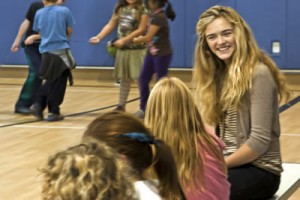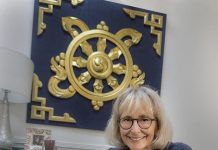
When the adult children of a couple who set up a new private family foundation showed no interest in freeing up time to devote to their parents’ project 12 years ago, estate attorney and Laguna Beach resident Mark Powell turned instead to their grandchildren. One child was thrilled to use his grandparents’ foundation to supply his down-and-out high school with a much needed basketball scoreboard.
At the unveiling of the scoreboard, Powell described watching the young man’s face light up with the realization that he had made such a difference in the lives of his peers. “It shaped me, too,” said Powell, who is determined to see more young faces light up.
After discovering first hand that younger candidates often provide more fertile ground than their elders when it comes to cultivating would-be philanthropists, Powell is sowing seeds in that high-yielding turf, beginning this fall with a group of 22 Laguna Beach High School students.
In a testament to his success thus far, students in a recent class proved undaunted at analyzing the tax return of the Boys and Girls Club of Laguna Beach and actively engaged in discussions with Powell about its finer points. Students had recently visited the club and witnessed what its staff and volunteers do for the kids who flock there daily. They also met with Laguna native Donny Crevier, former owner of Santa Ana’s Crevier BMW, a club member as a child and now a board member and staunch supporter.
Still, meeting nonprofit board members and examining tax returns are atypical pursuits for students, even those belonging to Mindy Hawkins’ Peer Assisted Leadership (PAL) class, meant to promote community service and develop leadership skills.
Powell is a trustee of the Laguna Beach Community Foundation, which aims to increase local philanthropy and provide charitable organizations tools to thrive. He recognized that schooling the next generation about philanthropy will broaden its base of potential donors in the future.
In August, his plan received Principal Joanne Culverhouse’s blessing and beginning Sept. 7 he found himself in Hawkins’ PAL class once a week.
While PAL students, who meet daily, are required to find weekly opportunities to assist others at the school, from tutoring to assisting Hawkins’ special ed students, Powell raised the bar by adding another dimension, said Hawkins. “The field trips Mark has provided have been amazing,” she said. Initially, students were more interested in hands-on experience rather than learning about nonprofit management, but now students appreciate understanding how nonprofits run and work, she said.
Powell quickly saw the value of giving students first-hand experiences to spark their interest as potential volunteers or donors before asking them to also evaluate facts. “You never know what’s going to get them excited,” he said of the need to vary the trips. A beach trip about preserving the environment involved meeting a representative from Coast Keeper and a marine protection officer. Future excursions include a visit to the J.F. Shea Therapeutic Riding Center and meeting with filmmaker and clean-ocean activist Greg McGillivary.
During the visit to the Boys and Girls Club, Crevier also presented each student with a copy of Jim Stovall’s book, “The Ultimate Gift,” urging them to read it and come up with their own versions of that gift. As a reward, Crevier invited the students to have lunch with him at his classic car museum on Dec. 2 to discuss what they’ve learned.
Powell’s guidance broadened the program “beyond the limited community service opportunities” and helped students assess charities in a more meaningful way, Hawkins said.
The students, who learned that tax returns for most viable nonprofits are available online at Guidestar.org, rose to the task of examining the Boys and Girls Club’s return and to applying the benchmarks of oversight organization Charity Navigator to judge a nonprofit’s effectiveness. Standards include, for example, that at least 65 percent of an organization’s income be spent on programs. The students deduced that the club spends 83 percent of its funds on programs, and generally scored high marks on other benchmarks.
The field trips also sparked enough interest in the students that some now volunteer for beach clean ups and others, such as Perry Nielson, Nina Bo, Jamie Hendrickson, Taylorann Barton, and Amanda Ozuna, volunteer at the club.
“I just love kids and playing with them,” said Perry, summing up the general consensus among her peers.
“People try to make these kids’ lives so much better,” said Jamie, adding that she hopes to volunteer outside of the PAL class.
“I like that a lot of their money goes to the programs,” said Amanda, proving that the forensic evaluation found fertile ground.
Now, Hawkins and Powell have challenged students to research a nonprofit they care about to learn its purpose, financial record and management practices. After each student makes a PowerPoint presentation in support of their choice, the class will evaluate them and select the top three to support.
Powell hopes to expand the program with more high school students and to include middle school students as well. Asked to measure his success at cultivating young philanthropists, Powell said, “It’s already happened.”





Wow! What a great idea – even greater that the kids latched onto it so readily. Mark Powell and his friends must be doing something right! Good going!